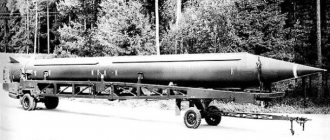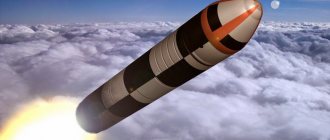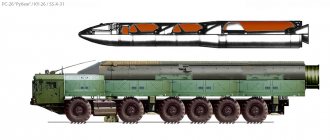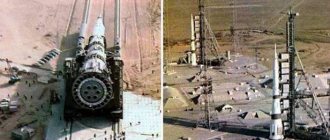RT-2PM2 "Topol-M" is a strategic missile system, work on the creation of which began in the Soviet period, but fine-tuning and mass production were carried out by Russian enterprises. Topol-M is the first ICBM model created after the collapse of the USSR. Today, the Russian army is armed with silo-based (15P165) and mobile (15P155) missile systems.
"Topol-M" was the result of the modernization of the Soviet strategic missile system "Topol", surpassing its predecessor in almost all main characteristics. Currently, Topol-M forms the basis of the Russian Strategic Missile Forces. It was developed by designers from the Moscow Institute of Thermal Engineering (MIT).
Since 2011, the Russian Ministry of Defense has stopped purchasing new Topol-M systems; resources have been directed to the creation and deployment of Yars RS-24 intercontinental ballistic missiles.
From the very beginning, the creators of the Topol-M missile system were given quite serious restrictions concerning, first of all, the overall characteristics of the missile. Therefore, the main emphasis in its development was on increasing the survivability of the complex in the face of enemy nuclear strikes and on the ability of the warheads to overcome the enemy missile defense system. The maximum firing range of the complex is 11 thousand km.
According to a number of experts, the Topol-M missile system is not an ideal option for the Russian Strategic Missile Forces. It had to be created due to the lack of other alternatives. The disadvantages of ICBMs are largely related to the characteristics of the Topol complex, on the basis of which it was created. And although the designers managed to improve many parameters, they, of course, could not perform a miracle.
History of creation
Work on a new intercontinental ballistic missile with solid propellant engines began in the mid-80s. The project was carried out by the Moscow Institute of Thermal Engineering and the Dnepropetrovsk Yuzhnoye Design Bureau. The designers were tasked with creating a universal rocket for stationary and mobile missile systems. The only difference between them was the engine of the warhead propagation stage: the designers planned to install a liquid engine on silo-based missiles, and a solid fuel engine on mobile systems.
In 1992, the Yuzhnoye Design Bureau ceased participation in the project, and the completion of development fell entirely on the shoulders of the Russian side. At the beginning of 1993, a presidential decree appeared that regulated further work on the missile system, and guarantees of further funding were also given. MIT was appointed as the lead enterprise for this project.
The designers needed to develop a universal missile, suitable for various types of deployment, with high accuracy, flight range, and capable of overcoming the enemy’s missile defense system.
Topol-M was created as a modernization of the Soviet Topol missile system. At the same time, the SVN-1 Treaty clearly defined what exactly was considered modernization and what characteristics of the complex should be changed. The new ballistic missile had to differ in one of the following characteristics:
- number of steps;
- type of fuel of at least one of the stages;
- the length of the rocket or the length of the first stage;
- diameter of the first stage;
- the mass that the rocket could throw;
- starting mass.
Based on the foregoing, it becomes clear that the designers of the missile system were initially very limited. Therefore, the tactical and technical characteristics (TTX) of the Topol-M missile could not differ significantly from its predecessor. The main differences were the missile's flight characteristics and its ability to overcome enemy missile defense.
Improved solid-fuel engines of the three stages of the rocket made it possible to significantly reduce the duration of the active phase of the rocket’s flight, which seriously reduced the likelihood of it being hit by anti-missile systems. The missile guidance system has become much more resistant to electromagnetic radiation and other factors of a nuclear explosion.
State tests of the new missile began in 1994. The Topol-M was successfully launched from the Plesetsk cosmodrome. Then several more launches were carried out, and in 1997 serial production of the Topol-M complex began. In 2000, the silo-based Topol-M missile system was put into service, and in the same year testing and launches of the mobile complex began.
The deployment of silo-based Topol-M began in 1997 in silos that were previously used for UR-100N missiles. At the end of 1998, the first missile regiment entered combat duty. The Topol-M mobile systems began to be supplied en masse to the troops in 2005, at the same time a new state rearmament program was adopted, according to which the Ministry of Defense planned to purchase 69 new ICBMs by 2022.
In 2005, the Topol-M missile with a maneuvering warhead was launched. It became part of the Russian Strategic Missile Forces program to create means to overcome the American missile defense system. A warhead with a ramjet hypersonic engine was also tested.
From 1994 to 2014, sixteen launches of the Topol-M ICBM were carried out, of which only one launch was considered unsuccessful: the missile deviated from its course and was eliminated. Launches were carried out both from silo-based installations and from mobile missile systems.
In 2008, a decision was announced to install multiple warheads on the Topol-M ICBM. The first such missiles began to enter service with the troops in 2010. A year earlier, it was announced that the production of the Topol-M mobile complexes would be stopped and work would begin on a complex with higher characteristics.
Bottom line
The characteristics of the Topol-M missile allow us to say with confidence that the enemy will be defeated in any conditions of warfare.
Our country's Strategic Missile Forces will always maintain parity, armed with such a strategic complex. And overseas “friends” will look back a hundred times before taking a rash aggressive step towards starting an armed conflict.
In addition to the Topol, the latest RS-24 Yars ICBM complex with a multiple warhead, which is finishing testing, will soon come into service.
The characteristics of this weapon are secret; the appearance of some data is possible only after the complex is on combat duty.
Complex structure
The basis of the Topol-M mobile and stationary missile system is the 15Zh65 ICBM.
The missile has three stages and a warhead expansion stage, all of which are equipped with solid propellant engines. Each stage has a one-piece body made of composite materials (“cocoon” type). Rocket engine nozzles are also made of carbon-based composite materials and are used to control the flight of the rocket. Unlike its predecessors, the Topol-M2 ICBM does not have lattice rudders and stabilizers.
The missile is launched from both complexes by mortar launch. The launch weight of the projectile is 47 tons.
The ICBM carries a monoblock thermonuclear warhead with a capacity of 0.55 Mt. The missile's warhead has a better utilization rate of fissile materials than its predecessors. It is possible to equip the missile with multiple warheads, unified with the Bulava ICBM. In this case, the number of warheads ranges from three to six. It is also possible to install a maneuvering warhead on the rocket.
The missile is equipped with a perfect system for overcoming the missile defense system, which significantly reduces the likelihood of hitting warheads. It can launch decoys that cannot be distinguished from real warheads in all spectrums of electromagnetic radiation (laser, optical, infrared and radar). Decoys are capable of completely repeating the characteristics of real warheads at all stages of their flight. Moreover, Topol-M decoys are capable of withstanding the damaging factors of a nuclear explosion and super-powerful laser irradiation.
The missile warheads have a special coating that reduces their visibility on radar screens, and can also release special aerosols - sources of infrared radiation. The rocket's new propulsion engines make it possible to significantly reduce the active portion of the flight, where it is most vulnerable. In addition, in this part of the flight the missile can maneuver, which makes its destruction even more problematic.
A high level of resistance of the missile and warheads against the damaging factors of a nuclear explosion was achieved through a whole range of measures:
- coating the rocket body with a special composition;
- application in creating a control system of an elementary base that is more resistant to electromagnetic pulses;
- the control system equipment is placed in a separate sealed compartment, coated with a special composition of rare earth elements;
- the rocket's cable network is reliably shielded;
- When the cloud of a nuclear explosion passes, the rocket makes a so-called program maneuver.
The power of the solid propellant charges of all rocket engines is significantly higher than that of its predecessors, which allows it to gain speed much faster.
The probability of overcoming the American missile defense system for Topol-M ICBM warheads is 60-65%, work is underway to increase this value to 80%.
The missile control system is inertial, based on a digital computer and a gyro-stabilized platform. “Topol-M” can successfully launch and complete its mission even in the event of high-altitude blocking nuclear strikes on the area where the complex is deployed.
It should be created using developments and technologies obtained in the manufacture of the Topol ICBM; this significantly reduced the time it took to create the missile, and also reduced the cost of the project.
The re-equipment of the Strategic Missile Forces units was carried out using existing infrastructure, which also made it possible to significantly reduce economic costs. This was especially important for the late 90s, when the Russian economy was going through hard times.
To install silo-based Topol-M missiles, silos of missiles removed from combat duty were used. The silo installations of Soviet heavy ICBMs were converted to use Topol. At the same time, an additional five meters of concrete were poured into the base of the shaft, and some additional transformations were carried out. Most of the mine equipment was reused, which significantly reduced the cost of deploying the complex and also speeded up the work.
Each stationary Topol-M missile system consists of ten missiles in launchers and one high-security command post. It is located in a special shaft on shock absorbers, which makes it less vulnerable to enemy strikes. The missile is enclosed in a special metal transport and launch container.
The mobile-based Topol-M is mounted on an MZKT-79221 all-terrain chassis with 8 axles. The missile is housed in a high-strength fiberglass transport and launch container. Structurally, the missiles of the mobile and silo complexes are no different. The weight of one launcher is 120 tons, and its length is 22 meters. Six pairs of wheels can turn, which provides the mobile complex with a minimum turning radius.
The specific pressure of the mobile unit's wheels on the ground is less than that of a conventional truck, which provides it with high maneuverability. The unit is equipped with a 12-cylinder engine with an output of 800 hp. With. It can ford a depth of 1.1 meters.
When creating the mobile complex, previous experience in creating similar machines was taken into account. High cross-country ability and maneuverability significantly increases the survivability of the complex, allowing it to leave the zone of a probable enemy strike in the shortest possible time.
The launch can be made from any ground, from any point of deployment of the complex, equipped with camouflage means against various detection means (optical, infrared, radar).
Serial production of launchers has been established at Volgograd.
In 2013, missile units armed with Topol-M mobile launchers received thirteen special camouflage and engineering support vehicles. Their main task is to destroy traces of missile systems, as well as create false positions that would be visible to the reconnaissance means of a potential enemy.
Possibility of accommodation
The complex can be either stationary or mobile based. Partial unification with the Bulava was carried out.
Mine launchers are used for placement. A silo is a vertical well with supporting structures with fastenings placed in it, as well as devices for servicing and launching a rocket.
On top it is covered with an armor plate, which can slide to the side or rise on a hinge, depending on the design features. Ensures compliance with specified climatic and temperature conditions. Maintains the rocket in constant readiness for launch. Currently, converted silo launchers from Stiletto and Voevoda are used for stationary complexes. In the silos, the missiles are placed in a metal transport and launch container.
One complex includes 10 missiles and a command module with a high degree of protection. The process of loading a rocket into the silo takes more than 8 hours. The combat duty period of one missile is up to 15 years.
To accommodate the Topol-M complex, the MZKT-79221 self-propelled chassis was used. This is a special multi-axle heavy-duty chassis, developed by Minsk designers in 1997.
Serial production started in 2000.
The wheelbase provides good maneuverability, overcoming various obstacles and driving on various types of soil. The rocket is housed in a fiberglass TPU, which performs all functions to ensure launch readiness. The dimensions of the mobile installation allow launching from almost any place:
- length - 22 meters;
- width - 3.4 meters;
- weight 120 tons.
The complex includes 9 mobile units, escort and security vehicles, and a control vehicle. Since 2013, the complex began to receive engineering camouflage vehicles. They hide traces of the complexes that entered the database. They also create clearly visible traces leading to false positions.
The area of responsibility along the patrol route of one complex is 25 thousand square kilometers.
Performance characteristics
| Maximum firing range, km | 11000 |
| Number of steps | 3 |
| Launch weight, t | 47,1 (47,2) |
| Throwing mass, t | 1,2 |
| Rocket length without head, m | 17,5 (17,9) |
| Rocket length, m | 22,7 |
| Maximum body diameter, m | 1,86 |
| Head type | monoblock, nuclear |
| Warhead equivalent, mt | 0,55 |
| Circular probable deviation, m | 200 |
| TPK diameter (without protruding parts), m | 1.95 (for 15P165 – 2.05) |
| MZKT-79221 (MAZ-7922) | |
| Wheel formula | 16×16 |
| Turning radius, m | 18 |
| Ground clearance, mm | 475 |
| Weight in running order (without combat equipment), t | 40 |
| Load capacity, t | 80 |
| Maximum speed, km/h | 45 |
| Cruising range, km | 500 |
Description of the Topol ballistic missile
RT-2PM "Topol" (according to NATO classification - "SS-25 "Sickle", GRAU-15Zh58) is a strategic complex with a solid fuel three-stage intercontinental ballistic missile.
Despite its appearance, the Topol ballistic missile is classified as light. The launcher is mobile and ground-based, and the control system has its own on-board computer (on-board computer).
See also the article Satan ballistic missile and its technical characteristics
ICBM "Topol"
Thanks to the on-board computer and the use of the latest type of solid fuel for each stage, the designers managed to increase the target firing range. In this case, the possible deviation will be only 150-200 m.
Layout diagram of the 15zh58 rocket
- Head part.
- Transition compartment.
- 3rd stage rocket propulsion engine.
- Connection compartment 2 stages.
- Main engine 2nd stage rocket.
- 1st stage connection compartment.
- 1st stage rocket propulsion engine.
- 1st stage tail section.
1st stage of the Topol ICBM
2nd stage ICBM "Topol"
3rd stage ICBM "Topol"
Tests
After entering service, Topol ICBMs are launched on average once every 6-12 months. In recent years, the reasons for testing, in addition to maintaining a high degree of combat readiness and training of Strategic Missile Forces personnel, were:
- checking a long-term storage rocket (20 years) November 29, 2005 (Plesetsk);
- study of an experimental warhead on August 28, 2008 (Plesetsk);
- inspection of promising combat equipment on December 27, 2013 (Kapustin Yar);
- ability to overcome missile defense systems September 9, 2016 (Plesetsk), December 26, 2022 (Kapustin Yar).
Launch of the Topol ICBM
Launch at the Kapustin Yar test site
Total from 1981 to 2022 120 launches were made. Tests have shown that the explosion radius of the Topol M depends on the power of the warhead and the number of separable parts.
See also the article Vintorez sniper rifle and its equipment











